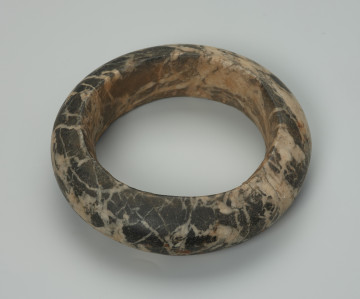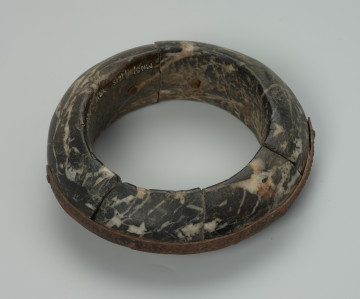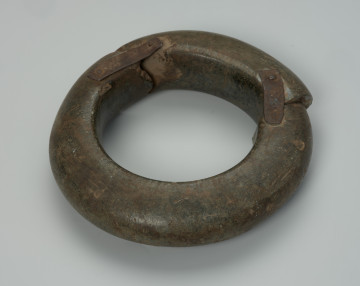
Men's bracelet
między 1930 — 1940
National Museum in Szczecin
Part of the collection: Collection of Dogonian art
The Dogon men formerly wore the stone bracelet on the forearm. It was probably acquired from the Tuareg, a pastoralist people inhabiting the Sahara and the borderlands of the Sahel (Algeria, Libya, Niger, Mali, Burkina Faso) who, apart from herding animals (e.g., sheep, goats, camels), also engaged in caravan transport. Bracelets of this type were called ahbeg in the Ahaggar dialect. They were worn by the Tuareg on the shoulder, just above the elbow. Ahbeg were given to young men together with a sword during the initiation rite. Sometimes they were passed from father to son. They were used as a defensive weapon during wrestling, and during warfare, they were used to apply pressure to the enemy's neck, which accelerated the cracking of the cervical vertebrae.In the Dogon country, trade has always been an essential part of life. According to Dogon mythology, it is closely linked to the twins who made the first exchange. The objects of their trade were cloth and kauri shells - objects that the Dogon believe contain life. When a trade is made, the buyer and seller are considered equal, like twins exchanging objects of equal value. The exchange takes place during the market, which is usually held once a week. The primary goods traded include crops, animals and salt from the Sahara. The caravans, led by Tuaregs, carry salt from Taoudeni, a mine in the Sahara, located about 500 km north of Timbuktu (Republic of Mali). With time, the salt trade was also taken up by the Dogon merchants. It is because it is a very profitable business (earnings comparable to the salary of a teacher - a well-paid profession). That is why nowadays, many Dogon men are involved in it.
Katarzyna Findlik-Gawron
Author / creator
Dimensions
cały obiekt: height: 3 cm, diameter: 11,9 cm
Object type
bracelet, jewellery
Creation time / dating
Creation / finding place
Identification number
Location / status

między 1930 — 1940
National Museum in Szczecin

między 1930 — 1940
National Museum in Szczecin

między 1930 — 1950
National Museum in Szczecin
DISCOVER this TOPIC
National Museum in Lublin
DISCOVER this PATH
Educational path